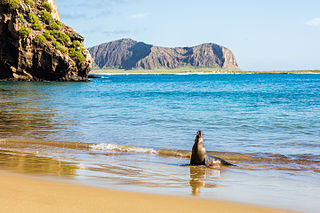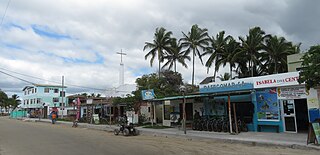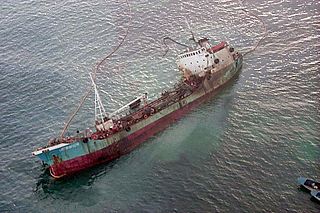
The Galápagos Islands, part of the Republic of Ecuador, are an archipelago of volcanic islands distributed on either side of the equator in the Pacific Ocean surrounding the centre of the Western Hemisphere. Located 906 km (563 mi) west of continental Ecuador, the islands are known for their large number of endemic species that were studied by Charles Darwin during the second voyage of HMS Beagle. His observations and collections contributed to the inception of Darwin's theory of evolution by means of natural selection.

The Dry Tortugas are a small group of islands, located in the Gulf of Mexico at the end of the Florida Keys, United States, about 67 miles (108 km) west of Key West, and 37 miles (60 km) west of the Marquesas Keys, the closest islands. Still farther west is the Tortugas Bank, which is submerged. The first Europeans to discover the islands were the Spanish in 1513, led by explorer Juan Ponce de León. The archipelago's name derives from the lack of fresh water springs, and the presence of turtles. They are an unincorporated area of Monroe County, Florida, and belong to the Lower Keys Census County Division. With their surrounding waters, they constitute the Dry Tortugas National Park.

Fernandina Island is the third largest, and youngest, island of the Galápagos Islands, as well as the furthest west. Like the others, the island was formed by the Galápagos hotspot. The island is an active shield volcano that has most recently been erupting since April 11, 2009.

Puerto Ayora is a town in central Galápagos, Ecuador. Located on the southern shore of Santa Cruz Island, it is the seat of Santa Cruz Canton. The town is named in honor of Isidro Ayora, an Ecuadorian president. The town is sometimes mistakenly referred to as Santa Cruz. Puerto Ayora is the most populous town in the Galápagos Islands, with more than 12,000 inhabitants.

Isabela Island is the largest island of the Galápagos with an area of 4,640 square kilometres (1,790 sq mi) and length of 100 kilometres (62 mi), almost four times larger than Santa Cruz, the second largest of the archipelago. It was named after Queen Isabella I of Castile. The island straddles the equator. This island was originally named Albemarle Island for the Duke of Albemarle by Ambrose Cowley, one of the first men to ever set foot on the islands, in 1684.

Santa Cruz Island is one of the Galápagos Islands with an area of 986 km2 (381 sq mi) and a maximum altitude of 864 metres (2,835 ft). Situated in the center of the archipelago, Santa Cruz is the second largest island after Isabela. Its capital is Puerto Ayora, the most populated urban centre in the islands. On Santa Cruz, there are some small villages, whose inhabitants work in agriculture and cattle raising.

Academy Bay is the natural harbor of Santa Cruz Island in the Galápagos Islands archipelago. The bay was named for the California Academy of Sciences, which sent an expedition here in 1905. It is home to the Charles Darwin Research Station, founded in 1959 to preserve and study the Galapagos wildlife. It was here that the crew of the Norwegian ship Alexandra was rescued in 1906.
Tortuga is the Spanish word for a turtle or tortoise. It may also refer to:

The Galápagos Marine Reserve (GMR) lies a thousand kilometres from the Ecuadorian mainland and covers an area of around 133,000 km2 (51,000 sq mi). The Galápagos Islands and the surrounding waters represent one of the world’s most unusual ecosystems and are rich areas of biodiversity. Recently granted UNESCO World Heritage Site status, the Galápagos Marine Reserve is the largest marine reserve in a developing country and the second largest reserve in the world.

Galápagos National Park, established in 1959 and beginning operations in 1968, is Ecuador's first national park and a UNESCO World Heritage Site.

The Galápagos tortoise complex or Galápagos giant tortoise complex are the largest living species of tortoise. Modern Galápagos tortoises can weigh up to 417 kg (919 lb). Today, giant tortoises exist on only two remote archipelagos: the Galápagos Islands about 1,000 km (620 mi) due west of mainland Ecuador; and Aldabrachelys gigantea of Aldabra in the Indian Ocean, 700 km (430 mi) east of Tanzania.

Puerto Villamil is a small port village located on the southeastern edge of Isla Isabela in the Galapagos Islands. Of the 2,200 people who live on Isabela, the majority live in Puerto Villamil. The harbor is frequently full with sailboats, as Villamil is a popular stop for private yachts making their way to the Marquesas Islands as it is the westernmost town in the Galapagos Islands. Puerto Villamil was founded in 1897 by Antonio Gil
Nameless Island is an islet of the Galápagos Islands group, in Ecuador, between Pinzón Island and Santa Cruz Island (Galápagos). The island is most commonly used for scuba diving.

Loggerhead Key is an uninhabited tropical island within the Dry Tortugas group of islands inside the Gulf of Mexico. At approximately 49 acres in size, it is the largest island of the Dry Tortugas. Despite being uninhabited, the island receives visitors, such as day visitors and campers. The island only has a few built structures, including the Dry Tortugas Light and a lightkeeper's house that was constructed in the 1920s. The island has drinking water derived using desalination technology and solar power. The Carnegie Marine Biological Laboratory operated on Loggerhead Key from 1904 to 1939.

MV Jessica was an oil tanker that was involved in an oil spill in the Galápagos Islands, a chain of islands 972 km (525 nmi) west of continental Ecuador, of which they are a part. The ship was registered in Ecuador and owned by Acotramar. On the evening of 16 January 2001, Jessica ran aground at Wreck Bay, at the entrance to the port of Puerto Baquerizo Moreno, the capital of the Galápagos Province, located on the southwestern coast of San Cristóbal Island. The ship was carrying 600 tons of diesel oil and 300 tons of intermediate fuel oil. The diesel was destined for the fuel dispatch station on Baltra Island, while the fuel oil was destined for the tourist vessel Galapagos Explorer.
Black turtle may refer to:

Chelonoidis is a genus of turtles in the tortoise family erected by Leopold Fitzinger in 1835. They are found in South America and the Galápagos Islands. They were formerly assigned to Geochelone, but a recent comparative genetic analysis has indicated that they are actually most closely related to African hingeback tortoises. Their ancestors apparently floated across the Atlantic in the Oligocene. This crossing was made possible by their ability to float with their heads up and to survive up to six months without food or water.
Tortuga Bay is located on the Santa Cruz Island, about a 20-minute water-taxi ride from the main water taxi dock in Puerto Ayora. There is also a walking path, which is 1.55 miles (2,490 m) and is open from six in the morning to six in the evening. Visitors must sign in and out at the start of the path with the Galapagos Park Service office. Tortuga Bay has a gigantic, perfectly preserved beach that is forbidden to swimmers and is preserved for the wildlife where many marine iguanas, galapagos crabs and birds are seen dotted along the volcanic rocks. There is a separate cove where you can swim where it is common to view white tip reef sharks swimming in groups and on occasion tiger sharks

Chelonoidis phantasticus is a species of Galápagos tortoise that was discovered in 1906 and not seen again until a single female was discovered living on Fernandina Island by an expedition in February 2019.














